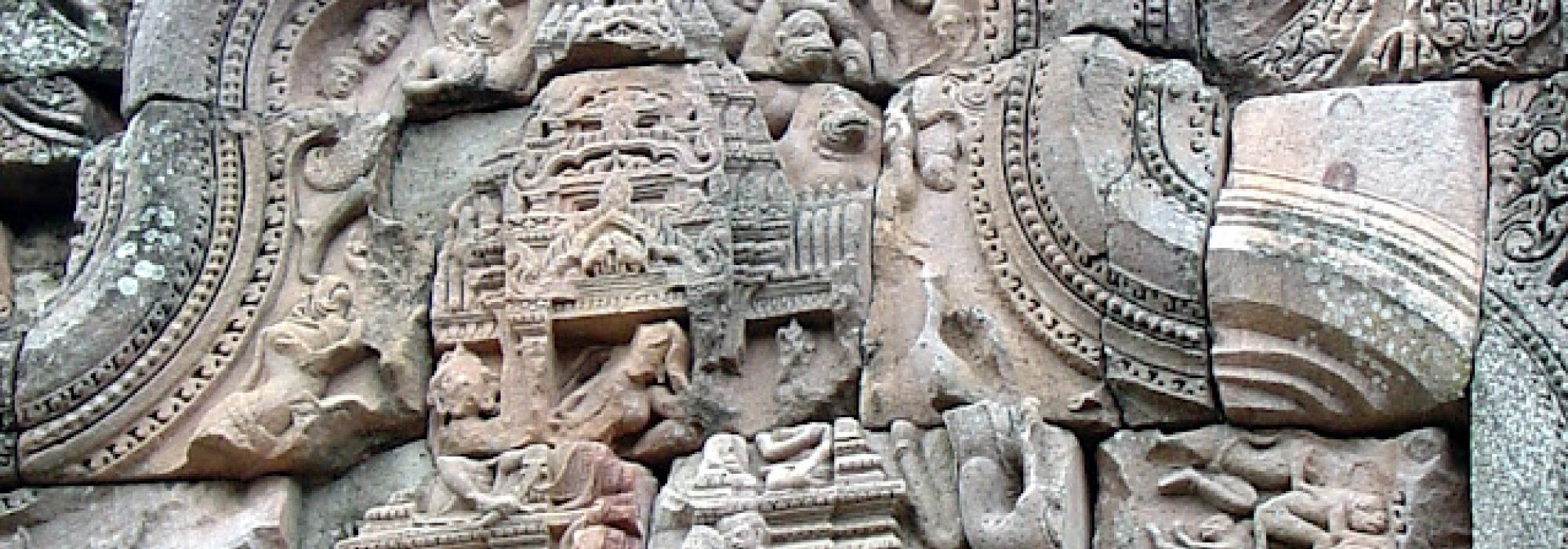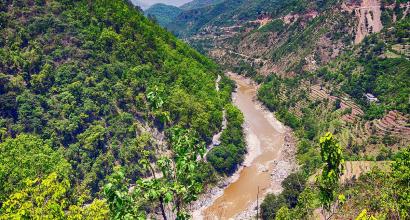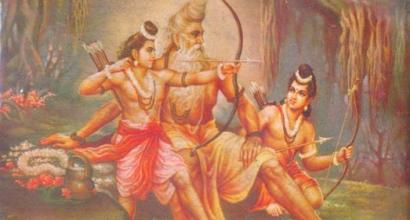Rāma observed many portents and advised Lakṣmaṇa that they must attack Rāvaṇa’s city without delay. He descended from the mountain Suvela and inspected his army of vānaras. He commanded them to march on to the citadel. The vānaras picked up rocks, boulders, and full-grown trees to use as their weapons. In no time, Rāma and Lakṣmaṇa along with the vānara army reached the ramparts of Laṅkā.
Rāma blocked the northern gate of the city which was guarded by Rāvaṇa. And as per Rāma’s instruction, the various prominent vānaras approached the other gates of the city. Lakṣmaṇa and Vibhīṣaṇa took the responsibility of assigning lakhs of vānaras to support the heroes who stood at each of the gates. Following this, Sugrīva and Jāmbavān took up their position at the central encampment, to the west of the place where Rāma stood. The vānaras were geared up for the battle and stood alert – their tails were erect and stretched upwards. With their faces contorted in rage, the vānaras flexed their muscles. The earth seemed to be fully covered with the warring vānaras and the sky with those who were still converging on to Laṅkā. They had occupied the city on all sides such that even wind could not enter.
The rākṣasas were dumbfounded looking at the ocean of vānaras. They raised a loud, deafening roar, just as the ocean would roar if it were being shattered.
Rāma sought the advice of his counsellors before proceeding with the siege. As per the advice of Vibhīṣaṇa, Rāma decided to send Vālī’s son Aṅgada as an envoy to Rāvaṇa. He summoned Aṅgada and said, “Giving up your fear, leap into the city of Laṅkā. Approach Rāvaṇa and convey to him the following words of mine:
“O witless person, devoid of kingdom and wealth! Desirer of death! You have wronged the ṛṣis, devas, gandharvas, apsarās, nāgas, yakṣas, and human kings; your arrogance will today be humbled. I have been tormented by you through the abduction of my wife and I stand before your gates with my weapon lifted at you. Now show me the strength with which you carried away Sītā by alluring me with an illusory deer. I will cleanse the earth of the rākṣasas with my sharp arrows. The best of the rākṣasas, the dhārmic Vibhīṣaṇa is by my side; he will soon become the lord of Laṅkā. Gather courage and fight me, rākṣasa! You will be purified once you are slain by my arrows. Take a last, good look at Laṅkā; your life is in my hands!”
Thus addressed by Rāma, Aṅgada leapt into the sky. Speeding his way through the city, he arrived at Rāvaṇa’s palace. He saw the lord of the rākṣasas seated calmly amidst his ministers. He introduced himself to Rāvaṇa and conveyed Rāma’s message without adding or omitting a word. Even as the valorous vānara was speaking, Rāvaṇa commanded his men, “Capture this fool and kill him!” Upon hearing Rāvaṇa’s command, four dreadful rākṣasas seized Aṅgada. The vānara freely allowed them to capture him so that he could demonstrate his power before the assembly of the rākṣasas. Aṅgada then leapt on to the top of the palace even as the rākṣasas clung to his arms like locusts. As he sped upwards, the rākṣasas fell from the sky to the ground even as their lord watched them. He then jumped upon the pinnacle of the palace and it crumbled down right before Rāvaṇa’s eyes. Aṅgada then proudly proclaimed his name and flew through the sky. Rāvaṇa got up with a towering rage, but foreseeing his own destruction, fell silent emitting sighs.
Rāma advanced with his troops to attack Laṅkā; the rākṣasas picked up their weapons and raced about. They reported to Rāvaṇa that Rāma was advancing. Rāvaṇa doubled the defences of the city and walked up to the terrace of the palace to see the reality for himself. He was aghast when he saw that Laṅkā along with the surrounding mountains and forests was enveloped by innumerable vānaras. Even as he stood watching, the vānaras started scaling the walls of Laṅkā. They leapt on to the tops of palaces and destroyed them. As they raged havoc, they shouted, “Victory to the powerful Rāma and mighty Lakṣmaṇa! Victory to Sugrīva!”
Upon Rāvaṇa’s command, his troops of rākṣasas rushed out boasting about their valorous deeds. The rākṣasas slaughtered the vānaras with their maces, spears, and battle-axes, while the vānaras slew them using rocks, trees, claws, and teeth. The earth grew thick with flesh and blood.
Rāma, Lakṣmaṇa, Sugrīva, Aṅgada, Hanūmān, Gaja, Gavākṣa, and other prominent warriors fought powerful rākṣasas in one-on-one combats. Indrajit wounded Aṅgada and the mighty vānara smashed his chariot and horses. Sugrīva killed Praghasa by attacking him with a saptaparṇa tree. As the two armies fought valiantly, the sun set and it was all dark around. Confused voices were then heard all around. The vānaras could be heard shouting, “Are you a rākṣasa?” and the rākṣasas cried, “Are you a vānara?” Commands such as, “Kill,” “Come here,” “Why are you fleeing?” were heard in the darkness.
Meanwhile, Rāma and Lakṣmaṇa shot arrows at the rākṣasas, who they could see in the dim light. The dust raised by the horses’ hooves and chariot wheels blocked the eyes of the warriors. The rākṣasas together tried to attack Rāma, but he slew them all at once. With his arrows, Rāma illuminated the skies. The night like the night of universal dissolution, Kālarātri, was dreadful to both the rākṣasas and vānaras. Arrows with their feathers cast in gold flew in all directions, and the night felt like a beautiful autumnal evening sparkling with fireflies. The roar of the warriors multiplied into a deafening sound as it resounded through the caverns and caves in the Mount Trikūṭa.
His horses and charioteer slain by Aṅgada, an enraged Indrajit shot nāgāstras at Rāma and Lakṣmaṇa. Pierced by the arrows, Rāma tried to search for Indrajit, who was performing the disappearing act using his magical skills. Indrajit shot innumerable arrows at the vānaras and wounded them gravely. The vānaras were not able to discern him, as he was obscured by darkness, just as the sun is by the clouds. Indrajit, who was as hard to discern as a scattered mass of collyrium boasted of his strength to Rāma and Lakṣmaṇa and shot sharp arrows at them. In no time, the brothers were bound by the arrows, and they trembled like Indra’s dhvaja that is loosened from its cords. Every part of their body was frozen and immobilized by Indrajit’s powerful arrows; blood oozed out from their bodies.
Vibhīṣaṇa, Sugrīva, Nīla, Hanūmān, and other prominent heroes arrived at the place where the brothers were fallen; they were all shaken looking at the sorry state of Rāma and Lakṣmaṇa. The vānaras scanned the sky but were not able to spot Indrajit, who had concealed himself in the battle using his power of his māyā. Vibhīṣaṇa, however, was able to look through the illusion and discern his older brother’s son. But Indrajit announced to the rākṣasas that Rāma and Lakṣmaṇa had fallen and his comrades felt gratified at his feat.
Looking at Sugrīva falling into despair, Vibhīṣaṇa wiped the vānara’s eyes with water and said, “Don’t grieve, O king of vānaras! Extreme tenderness may prove fatal amidst a battle. Stand guard about the brothers until they gain consciousness. Look, radiance has not deserted Rāma’s body; a dead person does not possess this kind of vital glow. Once the brothers wake up, they will dispel our fear. Stop the vānaras from spreading rumour from ear to ear. Console yourself and rally your troops, while I go through the army motivating them.”
Indrajit rushed to his father in great joy and declared to him that Rāma and Lakṣmaṇa had fallen. Rāvaṇa leapt from his throne in great delight and embraced his son amid the rākṣasas. Delighted at heart, he variously praised his son. He summoned the rākṣasīs including Trijaṭā who were guarding Sītā. He commanded them to take her in the puṣpaka-vimāna and show her the fallen brothers. Rāvaṇa hoped that Sītā, who would be thus dejected, would then accept him as her husband. The rākṣasīs obeyed his command. Once Sītā had been escorted, Rāvaṇa in a festive mood got the city decorated with flags, pennants, and banners. He announced to the rākṣasas that Indrajit had slain Rāghava and Lakṣmaṇa in battle.
Meanwhile, Sītā saw the brothers who were fallen unconscious in the battlefield. She saw them lying with their armours shattered, bows and arrows broken. Seeing the brothers, who were as powerful as the devas, fallen thus she assumed that they were dead and broke into uncontrollable lamentation. She cried saying, “All the predictions by the learned brāhmaṇas and lākṣaṇikas about me have proved to be false. They had declared that I will be the wife of a valorous and dhārmic king. Now I lament more for my mother-in-law than for my husband or for myself. The old lady must have been waiting to see her dear son return after the completion of his vow.” As Sītā was lamenting thus, Trijaṭā reassured her. She says, “Devi! Don’t despair. I am sure the brothers are dead. For, if their leaders were to be dead, we wouldn’t have seen his troops suffused with anger and excitement. Moreover, if Rāma was dead, you couldn’t have travelled in the puṣpaka-vimāna; it would have collapsed. Furthermore, when a leader is slain, his army goes in disarray, but we don’t see that happening here. The kākusthas have only been temporarily defeated in the battle by the power of Indrajit’s māyā. So, Jānakī! Give up your delusion and despair!” Sītā bowed down to Trijaṭā with her hands joined in reverence. Trijaṭā then took her back in the puṣpaka-vimāna to the aśoka-vana, traveling as fast as thought.
~
Back in the battlefield, Rāma regained consciousness but he saw that his brother Lakṣmaṇa was deeply wounded and drenched with blood. Unable to control his grief, Rāma fell into profound lamentation. He said, “Why do I care for Sītā or even myself when I see my brother lying this way? I could perhaps find another woman like Sītā if I search the world, but never can I find a brother, a companion, or a valorous warrior like Lakṣmaṇa. If this son of Sumitrā has attained pañcatva, I will immediately give up my life even as the vānaras stand watching. How can I face Sumitrā, or my mother Kausalyā or even my brothers Bharata and Śatrughna? What shall I tell them? O Lakṣmaṇa! You consoled me when I was broken, but now do not speak to me. Just as Lakṣmaṇa followed me to the forest, I will follow him to the abode of Yama. He always loved his family and was ever devoted to me. He is reduced to this pitiable state because of me, his ignoble brother; only because of my failed tactics and wrong decisions he has fallen. I have failed to make Vibhīṣaṇa the king of Laṅkā! Sugrīva, you must go back to your kingdom walking over the bridge that we had build. You have truly been a good friend and have helped me to the best of my capacities. My gratitude to Hanūmān for his valorous feats!”
Even as Rāma was lamenting thus, Vibhīṣaṇa who was trying to rally the troops rushed to Rāma, holding his mace. But the vānaras got scared looking at him, mistaking him for Indrajit; they fled in different directions. Sugrīva instructed Jāmbavān to reassemble the monkeys assuring them that it was only Vibhīṣaṇa. Sugrīva asked his father-in-law Suṣeṇa to take the wounded Rāma and Lakṣmaṇa back to Kiṣkindhā and pledged that he would alone kill Rāvaṇa and his kin. But Suṣeṇa recollected that in the past the devas were similarly turned unconscious by the dānavas; Bṛhaspati had healed them back then using medicinal herbs and the power of mantras. Suṣeṇa said, “The vānaras Sampāti and Panasa will recognise the healing herbs which are now in the kṣīra-sāgara. Let them go them with all speed to retrieve them. The two healing herbs named sañjīvakaraṇī and viśalya grow on the mountains called Candra and Droṇa; they were planted there by the devas. Hanūmān the son of Vāyu may go to fetch them!”
To be continued...
[The critically constituted text and the critical edition published by the Oriental Institute, Vadodara is the primary source. In addition, the Kannada rendering of the epic by Mahāmahopādhyāya Sri. N. Ranganatha Sharma and the English translation by Sri. N. Raghunathan have been referred.]











































